 Technology peripherals
Technology peripherals
 AI
AI
 Winning allies and understanding people's hearts, the latest Meta agent is a master negotiator
Winning allies and understanding people's hearts, the latest Meta agent is a master negotiator
Winning allies and understanding people's hearts, the latest Meta agent is a master negotiator
Gaming has long been a proving ground for advances in AI—from Deep Blue’s victory over chess grandmaster Garry Kasparov, to AlphaGo’s mastery of Go beyond humans, to Pluribus beating the best players at poker. . But a truly useful, omnipotent agent can't just play a board game and move chess pieces around. One can’t help but ask: Can we build a more effective and flexible agent that can use language to negotiate, persuade, and work with people to achieve strategic goals like humans?
In the history of games, there is a classic tabletop game Diplomacy. When many people see the game for the first time, they will be shocked by its map-style board. Think of it as a complex war game. In fact, this is not the case. This is a game that requires mobilizing language to win allies. It involves decision-making and negotiation. There is a lot of communication between players. The key to winning the game lies in the interaction between people.
Now Meta has launched a challenge to this game. The intelligent agent they built, CICERO, has become the first AI to reach human level in Diplomacy. CICERO demonstrated this on the online version webDiplomacy.net, where CICERO scored on average more than double that of human players and ranked in the top 10% of participants who had played more than one game.

- Paper address: https://www.science.org/doi/10.1126/ science.ade9097
- Homepage address: https://ai.facebook.com/research/cicero/diplomacy/
For ten years, Diplomacy has been regarded as an insurmountable challenge in the field of AI because the game requires players to understand the motivations and perspectives of others, make complex plans, adjust strategies, and use natural language to reach agreements with others on this basis. , persuade others to form partnerships and alliances, etc. These are still difficult for agents, and CICERO is still very effective in using natural language to negotiate with Diplomacy players.
Unlike chess and Go, Diplomacy is a game about people, not pieces. If an agent cannot tell whether an opponent is bluffing or actually sabotaging, it will quickly lose the game. Likewise, if an agent can't communicate like a human, show empathy, build relationships with others, and talk about the game - it won't find other players willing to cooperate with it.
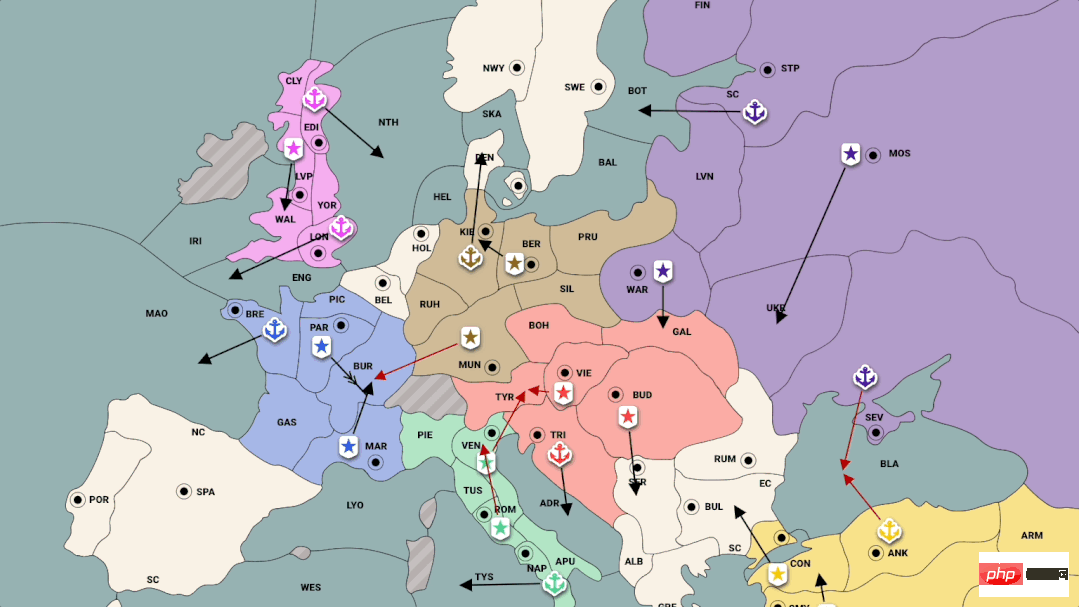
Meta’s research combines strategic reasoning (such as AlphaGo, Pluribus) with natural language processing (such as GPT-3, BlenderBot 3, LaMDA, OPT-175B) was combined. For example, late in the game CICERO deduces that it will need the support of a specific player, and CICERO then develops a strategy to win that person's favor.
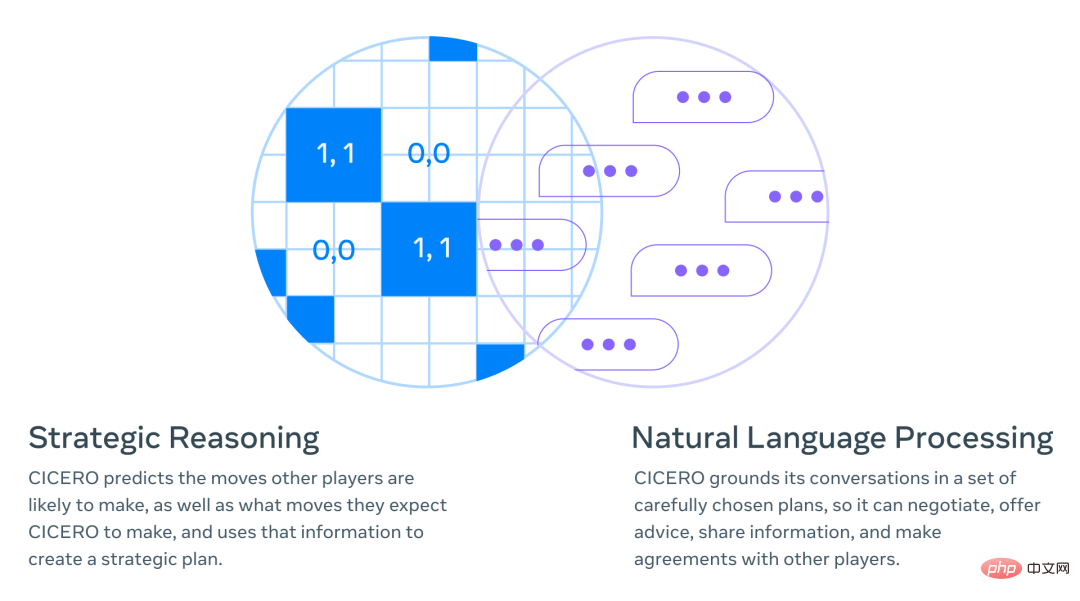
How to build CICERO
The core of CICERO is a controllable dialogue model and a strategic reasoning engine. At every point in the game, CICERO looks at the game board and its conversation history and models what other players might do. A plan is then developed to control the language model, communicate its plans to other players, and suggest reasonable actions to other players that coordinate well with them.
Controllable dialogue
In order to build a controllable dialogue model, Meta starts from a controllable dialogue model with 2.7 billion parameters. We started with a BART-like language model, pre-trained on text from the Internet, and fine-tuned on over 40,000 human games on webDiplomacy.net.
The implementation process is mainly divided into the following steps:
#Step 1: Based on the board state and the current dialogue, CICERO will make a decision for each person What gives an initial prediction.

Step 2: CICERO iteratively improves the initial forecast and then uses the improved forecast to form an intention for itself and its partners.
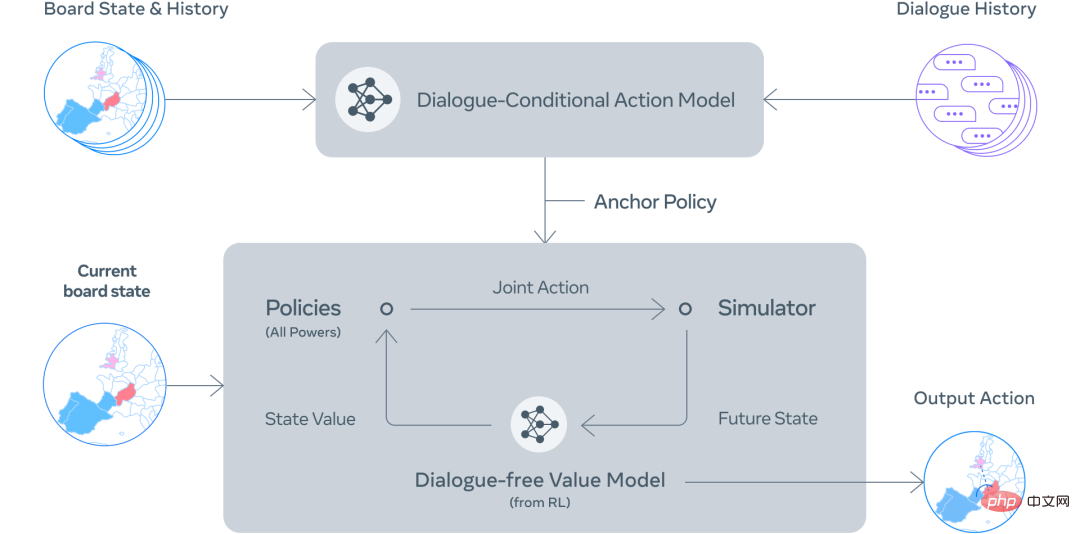
#Step 3: Generate multiple candidate messages based on board state, dialogue and intent.
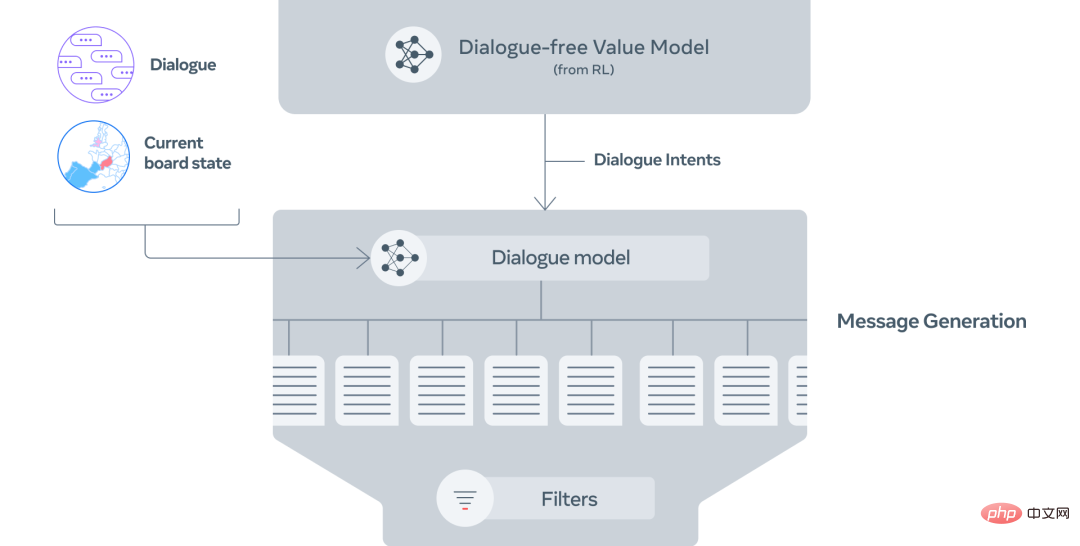
Step 4: Filter candidate messages, maximize the value, and ensure that the intentions of each other are consistent.

The researchers used some filtering mechanisms to further improve the quality of the dialogue, such as using trained classifiers to distinguish between humans and models Generated text to ensure - that dialogue makes sense, is consistent with the current game state and previous information, and is strategically sound.
Conversation-aware strategy and planning
In games involving cooperation, agents need to learn to simulate humans in reality What do people actually do in life, rather than treating humans as machines with agents dictating what they should do. Meta therefore hopes that the plans developed by CICERO will be consistent with the dialogue with other actors.
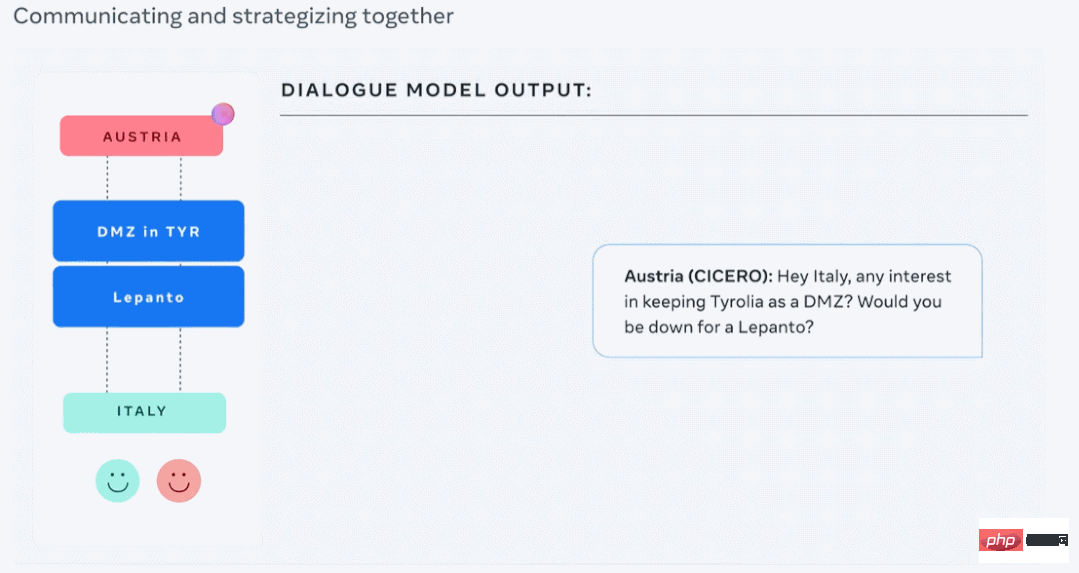
The classic method of human modeling is supervised learning, which uses labeled data (such as human players in past games action database) to train the agent. However, relying purely on supervised learning to choose actions based on past conversations results in an agent that is relatively weak and easily exploited. For example, a player could tell the agent "I'm glad we agreed that you will move your troops away from Paris!" Since similar information only appears in the training data when an agreement is reached, the agent may actually moved its troops away from Paris, even though doing so was a clear strategic mistake.
To solve this problem, CICERO runs an iterative planning algorithm to balance the consistency and reasonableness of the conversation. The agent first predicts each player's strategy for the current turn based on its conversations with other players, and also predicts what other players think the agent's strategy will be. It will then run a planning algorithm called "piKL", which iteratively improves these predictions by trying to choose new strategies with higher expected values given the strategies predicted by other players, while also trying to make the new predictions close to the original Strategic Forecasting. The researchers found that piKL can better simulate human games and bring better strategies to the agent than pure supervised learning.

Generate natural, purposeful dialogue
In In Diplomacy, how players talk to each other is even more important than how they move their pieces. CICERO is able to communicate clearly and persuasively when strategizing with other players. For example, in one demo, CICERO asked one player to immediately support a certain part of the board, while putting pressure on another player to consider an alliance later in the game.

In the exchange, CICERO attempts to execute its strategy by proposing actions to three different players. In the second conversation, the agent is able to tell the other players why they should cooperate and how it will benefit both parties. In this third dialogue, CICERO is both soliciting information and laying the groundwork for future action.
Weaknesses
It must be acknowledged that CICERO can sometimes produce inconsistent dialogue that undermines its goals. In the example below, CICERO plays Austria, but the agent asks Italy to move to Venice, contradicting its first message.

Let "Diplomacy" advance the sandbox of human-AI interaction
In an environment that involves both cooperation The emergence of goal-oriented dialogue systems in games that also involve competition poses important social and technical challenges in aligning AI with human intentions and goals. Diplomacy provides a particularly interesting setting for studying this problem, because playing the game requires wrestling with conflicting goals and translating these complex goals into natural language. As a simple example, a player may choose to compromise on short-term benefits to maintain a relationship with an ally because that ally may help them get into a better position next turn.
While Meta has made significant progress in this work, the ability to powerfully combine language models with concrete intents, and the technical (and normative) challenges of determining those intents, remain is an important question. By open sourcing the CICERO code, Meta hopes that AI researchers can continue to build on this work in a responsible way. The team said: “By using conversation models for zero-shot classification, we have taken early steps in detecting and removing harmful information in this new field. We hope that “Diplomacy” can serve as a safe sandbox to advance human-AI interaction. Research. 》
FUTURE DIRECTIONS
While CICERO is currently only capable of playing Diplomacy games, the technology behind this achievement is relevant to many real-world applications. For example, communication barriers between humans and AI-driven agents can be alleviated by controlling natural language generation through planning and RL.
For example, today’s AI assistants are great at answering simple questions, like telling you the weather, but what if they could sustain long-term conversations with the goal of teaching you a new skill?
Also, imagine a video game where NPCs can plan and talk like humans—understanding your motivations and tailoring dialogue accordingly to help you complete your quest to storm a castle.
These "dreams" may become reality in the future.
The above is the detailed content of Winning allies and understanding people's hearts, the latest Meta agent is a master negotiator. For more information, please follow other related articles on the PHP Chinese website!

Hot AI Tools

Undresser.AI Undress
AI-powered app for creating realistic nude photos

AI Clothes Remover
Online AI tool for removing clothes from photos.

Undress AI Tool
Undress images for free

Clothoff.io
AI clothes remover

Video Face Swap
Swap faces in any video effortlessly with our completely free AI face swap tool!

Hot Article

Hot Tools

Notepad++7.3.1
Easy-to-use and free code editor

SublimeText3 Chinese version
Chinese version, very easy to use

Zend Studio 13.0.1
Powerful PHP integrated development environment

Dreamweaver CS6
Visual web development tools

SublimeText3 Mac version
God-level code editing software (SublimeText3)

Hot Topics
 1664
1664
 14
14
 1421
1421
 52
52
 1315
1315
 25
25
 1266
1266
 29
29
 1239
1239
 24
24
 How to understand DMA operations in C?
Apr 28, 2025 pm 10:09 PM
How to understand DMA operations in C?
Apr 28, 2025 pm 10:09 PM
DMA in C refers to DirectMemoryAccess, a direct memory access technology, allowing hardware devices to directly transmit data to memory without CPU intervention. 1) DMA operation is highly dependent on hardware devices and drivers, and the implementation method varies from system to system. 2) Direct access to memory may bring security risks, and the correctness and security of the code must be ensured. 3) DMA can improve performance, but improper use may lead to degradation of system performance. Through practice and learning, we can master the skills of using DMA and maximize its effectiveness in scenarios such as high-speed data transmission and real-time signal processing.
 How to use the chrono library in C?
Apr 28, 2025 pm 10:18 PM
How to use the chrono library in C?
Apr 28, 2025 pm 10:18 PM
Using the chrono library in C can allow you to control time and time intervals more accurately. Let's explore the charm of this library. C's chrono library is part of the standard library, which provides a modern way to deal with time and time intervals. For programmers who have suffered from time.h and ctime, chrono is undoubtedly a boon. It not only improves the readability and maintainability of the code, but also provides higher accuracy and flexibility. Let's start with the basics. The chrono library mainly includes the following key components: std::chrono::system_clock: represents the system clock, used to obtain the current time. std::chron
 How to handle high DPI display in C?
Apr 28, 2025 pm 09:57 PM
How to handle high DPI display in C?
Apr 28, 2025 pm 09:57 PM
Handling high DPI display in C can be achieved through the following steps: 1) Understand DPI and scaling, use the operating system API to obtain DPI information and adjust the graphics output; 2) Handle cross-platform compatibility, use cross-platform graphics libraries such as SDL or Qt; 3) Perform performance optimization, improve performance through cache, hardware acceleration, and dynamic adjustment of the details level; 4) Solve common problems, such as blurred text and interface elements are too small, and solve by correctly applying DPI scaling.
 What is real-time operating system programming in C?
Apr 28, 2025 pm 10:15 PM
What is real-time operating system programming in C?
Apr 28, 2025 pm 10:15 PM
C performs well in real-time operating system (RTOS) programming, providing efficient execution efficiency and precise time management. 1) C Meet the needs of RTOS through direct operation of hardware resources and efficient memory management. 2) Using object-oriented features, C can design a flexible task scheduling system. 3) C supports efficient interrupt processing, but dynamic memory allocation and exception processing must be avoided to ensure real-time. 4) Template programming and inline functions help in performance optimization. 5) In practical applications, C can be used to implement an efficient logging system.
 How to measure thread performance in C?
Apr 28, 2025 pm 10:21 PM
How to measure thread performance in C?
Apr 28, 2025 pm 10:21 PM
Measuring thread performance in C can use the timing tools, performance analysis tools, and custom timers in the standard library. 1. Use the library to measure execution time. 2. Use gprof for performance analysis. The steps include adding the -pg option during compilation, running the program to generate a gmon.out file, and generating a performance report. 3. Use Valgrind's Callgrind module to perform more detailed analysis. The steps include running the program to generate the callgrind.out file and viewing the results using kcachegrind. 4. Custom timers can flexibly measure the execution time of a specific code segment. These methods help to fully understand thread performance and optimize code.
 Quantitative Exchange Ranking 2025 Top 10 Recommendations for Digital Currency Quantitative Trading APPs
Apr 30, 2025 pm 07:24 PM
Quantitative Exchange Ranking 2025 Top 10 Recommendations for Digital Currency Quantitative Trading APPs
Apr 30, 2025 pm 07:24 PM
The built-in quantization tools on the exchange include: 1. Binance: Provides Binance Futures quantitative module, low handling fees, and supports AI-assisted transactions. 2. OKX (Ouyi): Supports multi-account management and intelligent order routing, and provides institutional-level risk control. The independent quantitative strategy platforms include: 3. 3Commas: drag-and-drop strategy generator, suitable for multi-platform hedging arbitrage. 4. Quadency: Professional-level algorithm strategy library, supporting customized risk thresholds. 5. Pionex: Built-in 16 preset strategy, low transaction fee. Vertical domain tools include: 6. Cryptohopper: cloud-based quantitative platform, supporting 150 technical indicators. 7. Bitsgap:
 How to use string streams in C?
Apr 28, 2025 pm 09:12 PM
How to use string streams in C?
Apr 28, 2025 pm 09:12 PM
The main steps and precautions for using string streams in C are as follows: 1. Create an output string stream and convert data, such as converting integers into strings. 2. Apply to serialization of complex data structures, such as converting vector into strings. 3. Pay attention to performance issues and avoid frequent use of string streams when processing large amounts of data. You can consider using the append method of std::string. 4. Pay attention to memory management and avoid frequent creation and destruction of string stream objects. You can reuse or use std::stringstream.
 An efficient way to batch insert data in MySQL
Apr 29, 2025 pm 04:18 PM
An efficient way to batch insert data in MySQL
Apr 29, 2025 pm 04:18 PM
Efficient methods for batch inserting data in MySQL include: 1. Using INSERTINTO...VALUES syntax, 2. Using LOADDATAINFILE command, 3. Using transaction processing, 4. Adjust batch size, 5. Disable indexing, 6. Using INSERTIGNORE or INSERT...ONDUPLICATEKEYUPDATE, these methods can significantly improve database operation efficiency.



